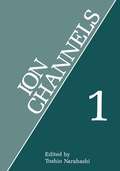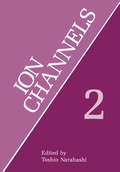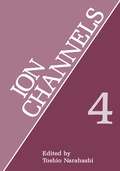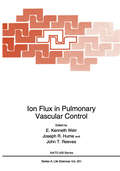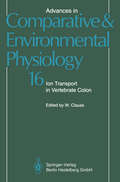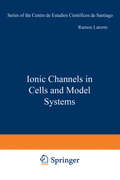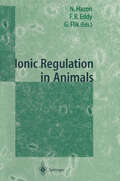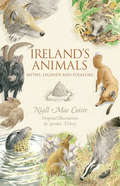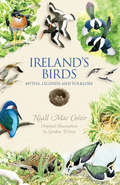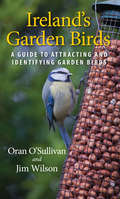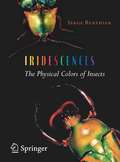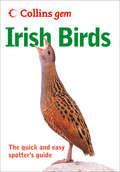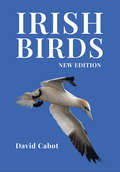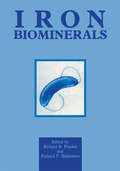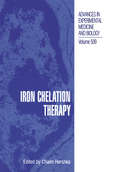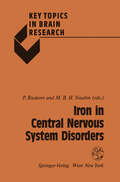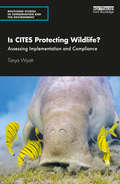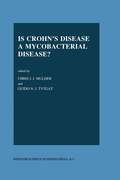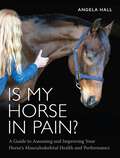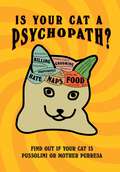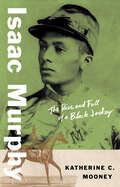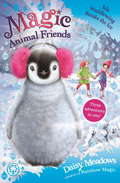- Table View
- List View
Ion Channels: Volume 1 (Ion Channels #1)
by T. NarahashiA wealth of information has been accumulated about the function of ion channels of excitable cells since the extensive and pioneering voltage clamp studies by Hodgkin, Huxley, and Katz 36 years ago. The study of ion chan nels has now reached a stage at which a quantum jump in progress is antici pated. There are many good reasons for this. Patch clamp techniques origi nally developed by Neher and Sakmann 12 years ago have made it possible to study the function of ion channels in a variety of cells. Membrane ionic currents can now be recorded practically from many types of cells using the whole-cell patch clamp technique. The opening and closing of individual ion channels can be analyzed using the single-channel patch clamp method. Techniques have also been developed to incorporate purified ion channels into lipid bilayers to reconstitute an "excitable membrane. " Advanced tech niques developed in molecular biology, genetics, and immunology, such as gene cloning and the use of monoclonal antibodies, are now being applied to the study of ion channels. A variety of drugs have now been found or are suspected to interact with ion channels to exert therapeutic effects. In addition to the classical exam ples, as represented by local anesthetics, many other drugs, including cal cium antagonists, psychoactive drugs, cardiac drugs, and anticonvulsants, shown to alter ion channel function. For certain pesticides such as have been pyrethroids and DDT, sodium channels are clearly the major target site.
Ion Channels (Ion Channels)
by T. NarahashiIn the past few years, the scientific community has witnessed rapid and significant progress in the study of ion channels. Technological advance ment in biophysics, molecular biology, and immunology has been greatly accelerated, making it possible to conduct experiments that were deemed very difficult if not impossible in the past. For example, patch-clamp tech niques can now be used to measure ionic currents generated by almost any type of cell, thereby allowing us to analyze single-channel events. It is now possible to incorporate purified ion channel components into lipid bilayers to reconstitute an "excitable membrane." Gene cloning and monoclonal antibody techniques provide us with new approaches to the study of the molecular structure of ion channels. A variety of drugs have now been found or are suspected to interact with ion channels to exert therapeutic effects. In addition to the classical exam ples, as represented by local anesthetics, many other drugs, including cal cium antagonists, psychoactive drugs, cardiac drugs, and anticonvulsants, have been shown to alter the ion channel function. For certain pesticides such as pyrethroids and DDT, sodium channels are clearly the major target site. Many diseases of excitable tissues are known to be associated with, if not caused by, dysfunction of ion channels; these include cardiac ar rhythmias, angina pectoris, cystic fibrosis, myotonia, and epilepsies, to men tion only a few. Channel dysfunction can now be studied due to theoretical and technological developments in this area.
Ion Channels (Ion Channels #4)
by T. Narahashi'Further establishes the reputation of the series...an invaluable resource.' -Trends in Pharmacological Sciences, from a review of Volume 3 Volume 4 explores such emergent topics as: three-dimensional conceptions of ion channel proteins based on the available structural and functional data; the structure, pharmacology, and regulation of the GABAA receptors; and the Ca2+-dependent K+ channels in adrenal chromatic cell membranes.
Ion Flux in Pulmonary Vascular Control (Nato Science Series A: #251)
by E. Kenneth Weir Joseph R. Hume John T. Reeves6 Ions can pass through a single membrane channel at a rate of 10 ions/second. Over the last decade the ability to measure ion flux so precisely and to document the opening and closing of individual ion channels has provided a powerful tool to those working on smooth muscle physiology and vascular reactivity. The use of potassium channel blockers by Tom Lloyd in the 1960s and calcium channel blockers by Ivan McMurtry in the 1970s indicated the importance of ion flux in regulating pulmonary vascular tone. Recent advances in technology. principally the patch-clamp technique and fluorescent ion-sensitive dyes. now permit a more detailed description of physiologic mechanisms. This volume arises from the Sixth Grover Conference on the Pulmonary Circulation. a NATO Advanced Research Workshop. held in Colorado in October 1992. A group of international sCientists who are leaders in the field of ion flux focused their attention on the problems of the pulmonary vasculature. The chapters in this book describe the present state of knowledge of the movement and storage of ions in vascular endothelial and smooth muscle cells. Those who are not familiar with the techniques of patch clamping and calcium imaging will find an introduction to these methods in the chapters by Leblanc and Wan and Archer et al. The role of potassium channels in oxygen sensing illustrates the rapid progress which the study of ion currents has made possible.
Ion Transport in Vertebrate Colon (Advances in Comparative and Environmental Physiology #16)
by W. Clauss M. Avella K. E. Barrett H. J. Binder D. C. Dawson W. V. Engelhardt R. Greger J. P. Hayslett R. Krattenmacher K. Kunzelmann B. Lahlou M. A. Post V. M. Rajendran G. Rechkemmer G. I. Sandle E. Skadhauge M. TilmanStudies on the colon not only serve medical interest or clinical purposes, but are also a highly interesting subject of comparative physiology, from which we can learn much about the basic principles in physiology. Presented here are examples of research on colonic ion transport of each vertebrate group, including the classical models of epithelia, rat and rabbit, and also on the special and unique features in fish, amphibians, reptiles, birds, and selected mammals such as the guinea pig. Physiology and pathophysiology of ion transport in the human large intestine are as well covered as the use of colonic cell cultures as model systems for crypt cell properties.
Ionic Channels in Cells and Model Systems (Series of the Centro De Estudios Científicos)
by Ramón LatorreThis book is based on a series of lectures for a course on ionic channels held in Santiago, Chile, on November 17-20, 1984. It is intended as a tutorial guide on the properties, function, modulation, and reconstitution of ionic channels, and it should be accessible to graduate students taking their first steps in this field. In the presentation there has been a deliberate emphasis on the spe cific methodologies used toward the understanding of the workings and function of channels. Thus, in the first section, we learn to "read" single channel records: how to interpret them in the theoretical frame of kinetic models, which information can be extracted from gating currents in re lation to the closing and opening processes, and how ion transport through an open channel can be explained in terms of fluctuating energy barriers. The importance of assessing unequivocally the origin and purity of mem brane preparations and the use of membrane vesicles and optical tech niques in the stUGY of ionic channels are also discussed in this section. The patch-clamp technique has made it possible to study ion channels in a variety of different cells and tissues not amenable to more conven tional electrophysiological methods. The second section, therefore, deals with the use of this technique in the characterization of ionic channels in different types of cells, ranging from plant protoplasts to photoreceptors.
Ionic Regulation in Animals: A Tribute to Professor W.T.W.Potts
by Neil Hazon F. Brian Eddy Gert FlikThis book draws together the most relevant and recent advances in the area of ionic transport in animals. In particular, it describes the role of modern cell and molecular biology research techniques in this rapidly advancing field. These techniques have led to important advances in our knowledge of cellular mechanisms of ion transporting epithelia, the role and expression of osmoregulatory hormones and a new understanding of whole body salt and water balance.
Ireland’s Animals: Myths, Legends And Folklore
by Niall Mac CoitirNiall Mac Coitir provides a comprehensive look at the folklore, legends and history of animals in Ireland, and describes their relations with people, being hunted for food, fur, sport, or as vermin, and their position today. A final section, inspired by stories of animal transformation, looks at twelve animals and how we can enrich our lives by visualising ourselves with their special qualities. This fascinating and beautifully illustrated compilation of folklore, legends and natural history will delight all with an interest in Ireland’s animals.
Ireland's Birds: Myths, Legends And Folklore
by Niall Mac CoitirBirds have been important symbols in our art and culture for thousands of years. They have inspired poets and painters, and feature in many place names and legends. In this book, Niall Mac Coitir draws together the mythology, legends and folklore of Ireland's birds, both wild and domestic. The birds are presented in seasonal order based on their migratory habits (the cuckoo and summer) or on their cultural associations (the robin with Christmas). He also explores how birds are often powerful symbols of various virtues and qualities, such as the goose, which is a symbol of watchfulness and bravery. This challenges us to look at birds in a different way, as dynamic creatures that have influenced our society over the millennia. Written with imagination and enthusiasm, this mix of natural history, mythology and folklore will delight and enlighten all interested in the birds of Ireland.
Ireland's Garden Birds: A Guide to Attracting and Identifying Garden Birds
by Oran O'Sullivan Jim WilsonAn essential companion for bird lovers and gardeners alike since it was first published, this highly successful guide to identifying garden birds has now been fully updated with the latest information and statistics. Highlighting a range of plants and planting schemes that support wildlife, it provides expert advice on making your garden a haven for birds. Learn everything you need to know about all the birds you’re most likely to see from your window, how to attract them into your garden and how to care for them. Each species is accessibly described, with details of identification, status and abundance, feeding habits, songs and call, and breeding season. The species guide has been updated to include the Great Spotted Woodpecker, which is now breeding regularly on the east coast and turning up in gardens. The species descriptions are enhanced by new photographs of the highest quality. Whether you are an avid gardener or just love feeding birds in your garden, this practical and easy-to-use guide is invaluable. Also available: 'Birds of Ireland – A Field Guide'
Iridescences: The Physical Colors of Insects
by Serge BerthierLepidoptera and Coleoptera – butterflies and beetles - are the most beautifully colored insects we can find. This book explores the origin of these brilliant colors from a physics perspective, beginning with the simplest question: Why Colors? The author masterfully explains at an introductory level the coloring of insects and illustrates his points with more than 240 brilliant figures. The book is a rich source for optical physicists, biologists, and teachers alike.
Irish birds (Collins Gem)
by David CabotAn introductory guide to 167 of the most frequently occurring birds in Ireland.
Irish Birds (Collins Gem Ser.)
by David CabotAn easy-to-use, fully illustrated guide to the birds of Ireland
Iron Chelation Therapy (Advances in Experimental Medicine and Biology #509)
by Chaim HershkoWithin the last few years, iron research has yielded exciting new insights into the under standing of normal iron homeostasis. However, normal iron physiology offers little protec tion from the toxic effects of pathological iron accumulation, because nature did not equip us with effective mechanisms of iron excretion. Excess iron may be effectively removed by phlebotomy in hereditary hemochromatosis, but this method cannot be applied to chronic anemias associated with iron overload. In these diseases, iron chelating therapy is the only method available for preventing early death caused mainly by myocardial and hepatic iron toxicity. Iron chelating therapy has changed the quality of life and life expectancy of thalassemic patients. However, the high cost and rigorous requirements of deferoxamine therapy, and the significant toxicity of deferiprone underline the need for the continued development of new and improved orally effective iron chelators. Such development, and the evolution of improved strategies of iron chelating therapy require better understanding of the pathophysiology of iron toxicity and the mechanism of action of iron chelating drugs. The timeliness of the present volume is underlined by several significant develop ments in recent years. New insights have been gained into the molecular basis of aberrant iron handling in hereditary disorders and the pathophysiology of iron overload (Chapters 1-5).
Iron in Central Nervous System Disorders (Key Topics in Brain Research)
by M. B. H.Youdim PeterRiedererThe role of the metals copper, zinc, magnesium, lead, manganese, mercury, lithium and aluminium in neuropsychiatric disease are well known and has been discussed on several occasions. Yet little attention has been paid to iron, the most abundant transitional metal in the body and the earth's crust. Iron plays a major role as a cofactor of numerous metabolic enzymes, it is important for DNA and protein synthesis, and has a crucial role in the oxygen carrying capacity of haemoglobin. Some of the most devastating diseases of systemic organs are associated with abnormal iron metabolism. Yet only very recently its role in the central nervous system has been considered. Thus nutritional iron defi ciency and iron overload afflict some 500-600 million people. It is also well recognized that too little or too much iron can produce profound effects on the metabolic state of the cell, and therefore the regulation of iron uptake and disposition is tightly relegated by the cell. Its transport into the cell and storage are handled by transferrin, ferritin and haemo siderin. Nowhere are these processes so well recognized as in the case of brain iron metabolism. Iron does not have ready access to the adult brain as it does to other tissues, since it does not cross the blood brain barrier (BBB). All the iron present in brain is deposited before the closure of BBB at an early age where it is sequestered and conserved. Therefore its turnover is extremely slow.
Iron Robin: A magical and soothing story for young readers
by Rose Tremain"Iron Robin combines everyday childhood themes with a pinch of fantasy, all brilliantly visualised by Jones’s expressive artwork" - The GuardianFrom an acclaimed voice in literature comes a children's story steeped in magic.Oliver loves birds - watching them soar into the sky and wishing that just sometimes they would stay close.So when he discovers a robin made of iron, he thinks he's found the perfect friend - even if his pet dragon isn't quite so certain! When the robin begins to glimmer and hop, Oliver is overjoyed, but in a terrible turn of events, this new friend is lost.But the magic of Iron Robin and the joy of friendship means that there is wonder and excitement ahead for Oliver...This lyrical and funny story is the perfect bedtime story to share together.
Is CITES Protecting Wildlife?: Assessing Implementation and Compliance (Routledge Studies in Conservation and the Environment)
by Tanya WyattThis book assesses the Convention on International Trade in Endangered Species of Wild Fauna and Flora (CITES), examining both implementation and compliance. Humans are causing a biodiversity crisis, where 1 million species are facing extinction. Species are dying, in no small part, because they are overexploited, poached and trafficked and CITES is the main international instrument designed to protect traded wildlife. Does the state of the world’s species mean CITES is failing? This book explores the implementation of and compliance with CITES by all 183 member countries. It is imperative we know the nature and extent of the implementation of and compliance with CITES legislation in all parties to fully understand the impact of legal and illegal trade on species survival. Through extensive legislative content analysis, a Delphi iterative survey, and semi-structured interviews, this is the first book to share empirical research about CITES implementation and compliance. This book contains a comprehensive analysis of the state of CITES, what is done well, what could be done better, and what the future might bring to try to curtail the slide of the world’s wildlife into extinction. By identifying lessons learned in relation to CITES legislation, implementation and compliance this book provides hard evidence to member countries as to how their own practice can be improved. This timely book will be essential reading for students and academics interested in wildlife law, trade and trafficking, green criminology and biodiversity conservation more broadly. It will also be of interest to professionals working in wildlife law enforcement.
Is CITES Protecting Wildlife?: Assessing Implementation and Compliance (Routledge Studies in Conservation and the Environment)
by Tanya WyattThis book assesses the Convention on International Trade in Endangered Species of Wild Fauna and Flora (CITES), examining both implementation and compliance. Humans are causing a biodiversity crisis, where 1 million species are facing extinction. Species are dying, in no small part, because they are overexploited, poached and trafficked and CITES is the main international instrument designed to protect traded wildlife. Does the state of the world’s species mean CITES is failing? This book explores the implementation of and compliance with CITES by all 183 member countries. It is imperative we know the nature and extent of the implementation of and compliance with CITES legislation in all parties to fully understand the impact of legal and illegal trade on species survival. Through extensive legislative content analysis, a Delphi iterative survey, and semi-structured interviews, this is the first book to share empirical research about CITES implementation and compliance. This book contains a comprehensive analysis of the state of CITES, what is done well, what could be done better, and what the future might bring to try to curtail the slide of the world’s wildlife into extinction. By identifying lessons learned in relation to CITES legislation, implementation and compliance this book provides hard evidence to member countries as to how their own practice can be improved. This timely book will be essential reading for students and academics interested in wildlife law, trade and trafficking, green criminology and biodiversity conservation more broadly. It will also be of interest to professionals working in wildlife law enforcement.
Is Crohn’s Disease a Mycobacterial Disease? (Developments in Gastroenterology #14)
by Guido N. J.Tytgat Chris J. J.MulderIS CROHN'S DISEASE A MYCOBACTERIAL DISEASE'! The fact that the differential diagnosis of inflammatory bowel disease includes intestinal infections has been a source of much interest and clinical concern for many years. Since the recognition of ulcerative colitis and Crohn's disease as clinical entities, numerous attempts have been made to identify a specific organism resulting in the clinical and pathologic picture of Inflammatory Bowel Disease. The first suggestion about a connection between Johne's disease, a chronic mycobacterial enteritis in cattle, and Crohn' s disease occurred in 1913, when Dalziel described enteritis in humans which, although resembling intestinal tuberculosis, he believed to be a new disorder. Since the work of Crohn in the thirties a few investigators attempted to look for mycobacteria in Crohn's disease. Until now the work of Van Patter, Burnham and others did not receive widespread recognition. In 1984 the isolation of M. paratuberculosis was reported by Chiodini et al. This report initiated the current interest and controversy about a mycobacterial etiology in Crohn's disease. The hypothesis "Crohn's disease is Johne's disease" did not receive widespread recognition, but has lead to the first muIticentered efforts to determine whether or not mycobacteria are associated with Crohn's disease.
Is My Horse in Pain?: A Guide to Assessing and Improving Your Horses Musculoskeletal Health and Performance
by Angela HallIs My Horse in Pain is an invaluable resource for all equestrians. The secrets of equine body language are unveiled, enabling readers to interpret the subtle messages hidden within the horse's gestures, postures and gaits. This book helps readers to understand and recognise these signs of pain and discomfort, taking appropriate measures to address and alleviate them. With this book acting as their guide, equestrians will be equipped with the tools to become knowledgeable and empathetic advocates, ensuring the well-being and happiness of their horses through enhanced performance and pain reduction.
Is Your Cat A Psychopath?
by Stephen WildishFind out if your cat is Pussolini or Mother PurresaIn ancient Egypt cats were viewed as gods and in modern day they are no stranger to worship as the internet's favourite animal, but have you ever stopped to consider the true nature of the smug little creatures we so willingly welcome into our homes? Is your cat a dazzling Dolly Purrton in the making? Or a hateful Hannibal Lickter waiting to strike? Find out with this killer purrsonality quiz. With 16 personality profiles and tips on how to live in harmony with your cat, whatever their result, find out if your furry housemate dreams of world peace or world domination.
Isaac Murphy: The Rise and Fall of a Black Jockey (Black Lives)
by Katherine C. MooneyThe rise and fall of one of America’s first Black sports celebrities Isaac Murphy, born enslaved in 1861, still reigns as one of the greatest jockeys in American history. Black jockeys like Murphy were at the top of the most popular sport in America at the end of the nineteenth century. They were internationally famous, the first African American superstar athletes—and with wins in three Kentucky Derbies and countless other prestigious races, Murphy was the greatest of them all. At the same time, he lived through the seismic events of Emancipation and Reconstruction and formative conflicts over freedom and equality in the United States. And inevitably he was drawn into those conflicts, with devastating consequences. Katherine C. Mooney uncovers the history of Murphy’s troubled life, his death in 1896 at age thirty-five, and his afterlife. In recounting Murphy’s personal story, she also tells two of the great stories of change in nineteenth-century America: the debates over what a multiracial democracy might look like and the battles over who was to hold power in an economy that increasingly resembled the corporate, wealth-polarized world we know today.
Isla Waddlewing Breaks the Ice: Special 7 (Magic Animal Friends #7)
by Daisy MeadowsAn enchanting series full of adorable animals, magic and friendship - from the creator of RAINBOW MAGIC, the UK's bestselling series for girls aged 5-7.In the magical land of Friendship Forest, Lily and Jess are going to a magical Ice Show! But wicked witch Grizelda is planning to spoil the special day with a nasty spell. Can adorable penguin Isla Waddlewing help save Snowdrop Slopes before it melts away?
Island Bats: Evolution, Ecology, and Conservation
by Theodore H. Fleming P. A. RaceyThe second largest order of mammals, Chiroptera comprises more than one thousand species of bats. Because of their mobility, bats are often the only native mammals on isolated oceanic islands, where more than half of all bat species live. These island bats represent an evolutionarily distinctive and ecologically significant part of the earth’s biological diversity. Island Bats is the first book to focus solely on the evolution, ecology, and conservation of bats living in the world’s island ecosystems. Among other topics, the contributors to this volume examine how the earth’s history has affected the evolution of island bats, investigate how bat populations are affected by volcanic eruptions and hurricanes, and explore the threat of extinction from human disturbance. Geographically diverse, the volume includes studies of the islands of the Caribbean, the Western Indian Ocean, Micronesia, Indonesia, the Philippines, and New Zealand. With its wealth of information from long-term studies, Island Bats provides timely and valuable information about how this fauna has evolved and how it can be conserved.
